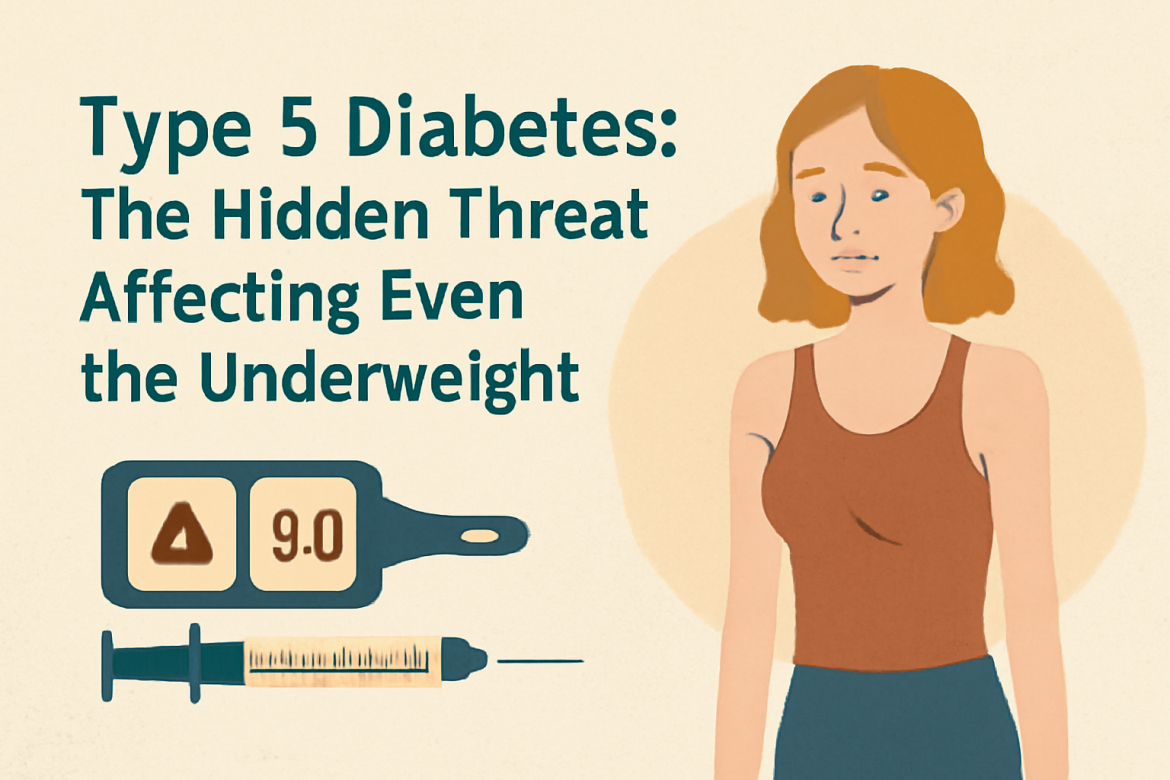Background: Rethinking the Link Between Obesity and Diabetes
For decades, diabetes has been closely associated with obesity and high body mass index (BMI). In both public health messaging and clinical practice, a high BMI has been viewed as a key indicator of risk for type 2 diabetes. However, recent global research is challenging this conventional wisdom by identifying a distinct category of diabetes affecting underweight individuals.
At the World Diabetes Congress held in Bangkok, Thailand, leading researchers revealed findings about a lesser-known form of the disease, now termed “Type 5 Diabetes.” This variant impacts individuals with a BMI below 19—classified as underweight—who do not fit the traditional profile of a diabetic patient.
What Is Type 5 Diabetes?
Type 5 diabetes is emerging as a condition distinct from both Type 1 (autoimmune) and Type 2 (lifestyle-associated) diabetes. It primarily affects people who are underweight or malnourished, often living in low-income or food-insecure regions.
Unlike Type 2 diabetes, which is typically linked to obesity and insulin resistance, Type 5 diabetes involves the body’s inability to produce adequate insulin, despite low fat and sugar levels in the body. This can result in dangerously elevated blood sugar levels and can go undiagnosed due to the patient’s non-typical appearance.
BMI (Body Mass Index) is used to assess weight relative to height, with a BMI below 18.5 considered underweight. According to studies presented at the Bangkok conference, some patients with Type 5 diabetes had BMIs as low as 17 or 16, showing no signs of obesity yet still exhibiting diabetic symptoms.
Medical Insight and Treatment Differences
Professor Peter Schwarz, President of the International Diabetes Federation, emphasized the importance of recognizing these cases as a separate category. “These are not Type 2 patients. They need their own diagnostic criteria and treatment protocols,” he said.
Dr. Felix Jebasingh from the Christian Medical College in Vellore, India, noted that Type 5 diabetes can often be managed with oral medications that help control blood sugar levels. This contrasts with Type 2 diabetes, where patients may require insulin injections due to higher insulin resistance.
While Type 5 diabetes is still being studied for optimal treatment, significant breakthroughs are also being made in Type 1 diabetes care. A recent discovery involving the drug Zimislecel offers promising results for Type 1 patients, marking a major step forward in personalized diabetes therapy.
Crucially, Jebasingh warns against misdiagnosis. “If underweight individuals are treated with therapies meant for Type 1 or Type 2 diabetes, the outcome could be harmful,” he explained. “We need more awareness among healthcare providers and distinct guidelines for this variant.”
Historical Context: Rediscovery of an Overlooked Disease
The concept of malnutrition-related diabetes is not entirely new. In 1955, researchers in Jamaica documented cases of diabetes in undernourished individuals, leading to the identification of what was later called Malnutrition-Related Diabetes Mellitus (MRDM). In 1985, the World Health Organization (WHO) recognized MRDM as a legitimate condition but removed it from official classifications in 1999, citing insufficient evidence.
However, new data is reigniting the debate. A 2022 study in India analyzed 73 individuals with low BMI and found that 20 of them showed signs of diabetes linked to nutritional deficiencies. The study involved researchers from India, the United States, and other countries, signaling renewed global interest in understanding this lesser-known threat.
Implications for Low-Income Countries
Type 5 diabetes is believed to disproportionately affect people in low-income nations, where access to proper nutrition is limited and healthcare systems often lack resources for complex diagnosis.
Countries across South Asia, Sub-Saharan Africa, and parts of Latin America may be particularly vulnerable. “We’ve been looking in the wrong direction—focusing only on obesity as a risk factor while ignoring undernutrition,” said Professor Schwarz.
Given the overlap between poverty, undernutrition, and poor healthcare access, Type 5 diabetes may be underdiagnosed and undertreated across vast populations.
Conclusion: One Size Does Not Fit All in Diabetes Diagnosis
The discovery of Type 5 diabetes highlights the urgent need to individualize medical assessments, particularly in regions where malnutrition is common. Experts argue that relying solely on weight or BMI to diagnose or rule out diabetes can lead to misdiagnosis and inappropriate treatment.
As research continues, public health policies and clinical practices will need to adapt. Better training for healthcare providers, increased awareness, and further studies are essential to ensure that patients with Type 5 diabetes receive the care they need—before it’s too late.















